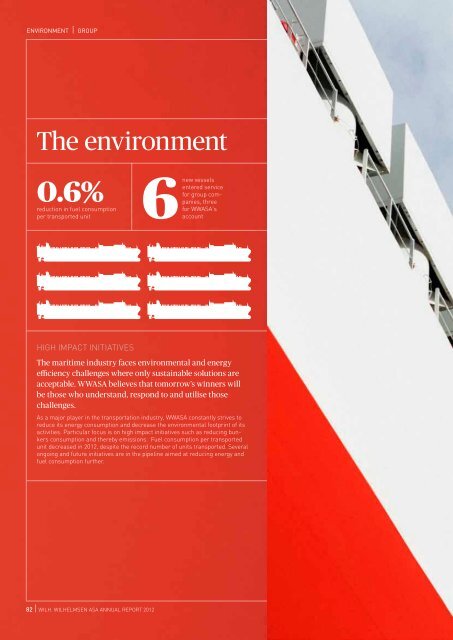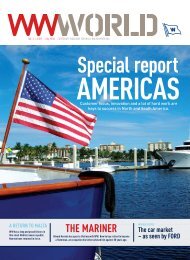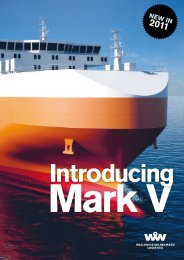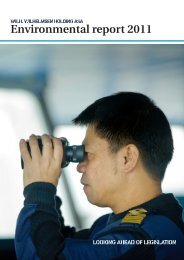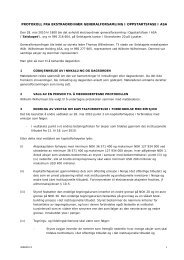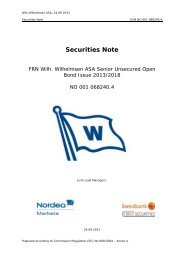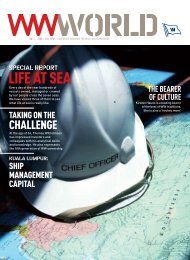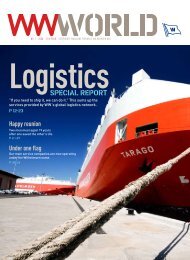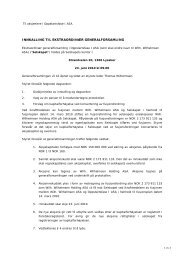PDF version - Wilh. Wilhelmsen ASA
PDF version - Wilh. Wilhelmsen ASA
PDF version - Wilh. Wilhelmsen ASA
You also want an ePaper? Increase the reach of your titles
YUMPU automatically turns print PDFs into web optimized ePapers that Google loves.
environment | group<br />
The environment<br />
0.6%<br />
6<br />
reduction in fuel consumption<br />
per transported unit<br />
new vessels<br />
entered service<br />
for group companies,<br />
three<br />
for WW<strong>ASA</strong>'s<br />
account<br />
High impact initiatives<br />
The maritime industry faces environmental and energy<br />
efficiency challenges where only sustainable solutions are<br />
acceptable. WW<strong>ASA</strong> believes that tomorrow’s winners will<br />
be those who understand, respond to and utilise those<br />
challenges.<br />
As a major player in the transportation industry, WW<strong>ASA</strong> constantly strives to<br />
reduce its energy consumption and decrease the environmental footprint of its<br />
activities. Particular focus is on high impact initiatives such as reducing bunkers<br />
consumption and thereby emissions. Fuel consumption per transported<br />
unit decreased in 2012, despite the record number of units transported. Several<br />
ongoing and future initiatives are in the pipeline aimed at reducing energy and<br />
fuel consumption further.<br />
82 | <strong>Wilh</strong>. <strong>Wilh</strong>elmsen <strong>ASA</strong> Annual Report 2012
group | environment<br />
High environmental standards<br />
Good for the industry,<br />
good for wwasa<br />
We strive to deliver services to our<br />
customers and stakeholders with<br />
minimal effect on the environment.<br />
We acknowledge the environmental<br />
challenges faced by the maritime<br />
industry and see that only sustainable<br />
solutions are acceptable.<br />
We believe that shipping companies which<br />
understand, respond to and utilise the energy<br />
efficiency and environmental challenges in<br />
our industry, will be tomorrow’s winners, and<br />
that new business opportunities will emerge<br />
as a result of these challenges. An example of<br />
this was an initiative that we mounted in 2012<br />
together with our partner Wallenius and the<br />
weather company StormGeo. Through a joint<br />
venture we will develop software solutions that<br />
optimize voyages, by decision support tools, and<br />
contribute to more fuel efficient operations.<br />
We see opportunities for making this gamechanging<br />
technology and solution commercially<br />
available to the global merchant fleet. We also<br />
work continually with other partners, shipping<br />
companies and institutions of higher learning on<br />
projects aimed at further enhancing the shipping<br />
industry’s energy and environmental advantages<br />
compared to other modes of transportation.<br />
To achieve our environmental targets we set<br />
high environmental objectives and goals for all<br />
our operating companies, technical managers<br />
and other stakeholders. All our vessels and<br />
technical managers shall as a minimum comply<br />
with international and environmental standards<br />
as well as our self imposed requirements. The<br />
key to accomplish the results we are after is<br />
our competent and empowered employees.<br />
In 2012, together with key stakeholders, we<br />
launched an energy efficiency competition for<br />
sailing personnel and technical management<br />
focusing on energy management solutions to be<br />
implemented on our fleet. Many of the entries are<br />
already implemented through the Ship Energy<br />
Efficiency Management Plan, which is now<br />
onboard all WW<strong>ASA</strong> vessels.<br />
We are committed to comply with not only<br />
national and international environmental<br />
legislation and regulations, but also to our own<br />
high standards. We work actively to influence<br />
the development of environmental legislation<br />
aimed at fair, predictable and practicable rules<br />
and regulations for a sustainable shipping<br />
industry. Our efforts to limit emissions to air and<br />
discharges to sea are based on the international<br />
regulations as in the IMO’s Marpol 73/78<br />
convention. In addition, a number of special<br />
national requirements must be taken into<br />
account, like the Emission Control Areas (ECAs)<br />
that impose stricter regulations for emissions<br />
to air. These ECAs are already implemented in<br />
many regions, and more are expected. There is<br />
no single solution to comply with these coming<br />
regulations, which is why we in 2013 will install<br />
and test an exhaust gas cleaning system onboard<br />
one of our vessels to ensure cost-efficient and safe<br />
operations within these areas.<br />
This report focuses primarily on vessels owned<br />
and controlled by WW<strong>ASA</strong>. A fleet environmental<br />
plan has been developed that tracks processes<br />
influencing emissions to air. The findings are<br />
compared with results from earlier years,<br />
and these comparisons are used to evaluate<br />
environmental targets for the future.<br />
Jan Eyvin Wang<br />
President and CEO<br />
<strong>Wilh</strong>. <strong>Wilh</strong>elmsen <strong>ASA</strong> Annual Report 2012 | 85
environment | group<br />
Environmental<br />
account 2012<br />
As a shaper of the maritime industry,<br />
we are pursuing numerous initiatives<br />
aimed at reducing the environmental<br />
impact of our business. Our vision is<br />
to continuously improve our operations<br />
and seek to achieve minimum<br />
emissions.<br />
This account incorporates the 35 vessels owned<br />
and controlled by WW<strong>ASA</strong> and operated by<br />
Wallenius <strong>Wilh</strong>elmsen Logistics and EUKOR<br />
Car Carriers.<br />
Despite a new record in shipping volumes in 2012,<br />
the fuel spent per cargo tonne over distance<br />
(g/tonne nm) decreased by 0.6%, showing that<br />
our vessels have been operated more efficiently<br />
than ever before.<br />
Total SOx and NOx emissions were higher in 2012<br />
than in 2011 due to increased number of vessels<br />
in the fleet , while emissions per transported unit<br />
came down.<br />
Average sulphur content in fuel consumed on<br />
board our vessels in 2012 was 1.80%, which is<br />
far below the legislative limit of 3.5% set by the<br />
International Maritime Organisation (IMO).<br />
During 2012 the group took delivery of three new<br />
vessels for WW<strong>ASA</strong>'s own account: MV Tysla,<br />
MV Tulane, and MV Tongala. No vessels were<br />
recycled in 2012.<br />
Total C0 2 emissions (thousand tonnes) Total N0 X emissions (thousand tonnes)<br />
1 600 40<br />
1 400 35<br />
1 200 30<br />
1 000 25<br />
800 20<br />
600 15<br />
400 10<br />
200 5<br />
0 0<br />
2005 2006 2007 2008 2009 2010 2011 2012 2005 2006 2007 2008 2009 2010 2011 2012<br />
Total S0 X emissions <br />
(thousand tonnes)<br />
g fuel/tonne nm<br />
18<br />
16<br />
14<br />
12<br />
10<br />
8<br />
6<br />
4<br />
2<br />
0<br />
30<br />
25<br />
20<br />
15<br />
10<br />
5<br />
0<br />
2005 2006 2007 2008 2009 2010 2011 2012 2005 2006 2007 2008 2009 2010 2011 2012<br />
86 | <strong>Wilh</strong>. <strong>Wilh</strong>elmsen <strong>ASA</strong> Annual Report 2012
group | environment<br />
WW Fleet<br />
Flag and ownership status as per 31.12.2012<br />
NAME BUILT TYPE FLAG Owner Ownership<br />
PCTC<br />
Operating<br />
company<br />
TORONTO 2005/8 PCTC UK Lloyds TSB Marine Leasing Bareboat WWL<br />
TOLEDO 2005/2 PCTC UK Lloyds TSB Marine Leasing Bareboat WWL<br />
TORRENS 2004/10 PCTC UK Lloyds TSB Marine Leasing Bareboat WWL<br />
TOPEKA 2006/06 PCTC UK <strong>Wilh</strong>elmsen Lines Car Carriers 100 % WWL<br />
TOMBARRA 2006/09 PCTC UK <strong>Wilh</strong>elmsen Lines Car Carriers 100 % WWL<br />
TORTUGAS 2006/12 PCTC UK <strong>Wilh</strong>elmsen Lines Car Carriers 100 % WWL<br />
TOMAR 2008/10 PCTC UK <strong>Wilh</strong>elmsen Lines Car Carriers 100 % WWL<br />
TOREADOR 2008/12 PCTC UK <strong>Wilh</strong>elmsen Lines Car Carriers 100 % WWL<br />
TORINO 2009/03 PCTC UK <strong>Wilh</strong>elmsen Lines Car Carriers 100 % WWL<br />
TOSCANA 2009/06 PCTC UK <strong>Wilh</strong>elmsen Lines Car Carriers 100 % WWL<br />
TONGALA 2012/09 PCTC UK <strong>Wilh</strong>elmsen Lines Shipowning Malta 100 % WWL<br />
TAKARA 1986/09 PCTC NIS Caiano Shipping Bareboat Eukor<br />
TAI SHAN 1986/12 PCTC NIS Caiano Shipping Bareboat Eukor<br />
TANCRED 1987/04 PCTC NIS ICON Tancred Bareboat Eukor<br />
TRINIDAD 1987/09 PCTC NIS ICON Trinidad Bareboat Eukor<br />
TRIANON 1987/04 PCTC NIS ICON Trianon Bareboat Eukor<br />
TAGUS 1985/03 PCTC NIS <strong>Wilh</strong>elmsen Lines Shipowning 100 % WWL<br />
TASCO 1985/02 PCTC NIS <strong>Wilh</strong>elmsen Lines Shipowning 100 % WWL<br />
TERRIER 1982/11 PCTC NIS <strong>Wilh</strong>elmsen Lines Shipowning 100 % Eukor<br />
MORNING CONCERT 2006/04 PCTC UK <strong>Wilh</strong>elmsen Lines Car Carriers 100 % Eukor<br />
LCTC<br />
TIJUCA 2008/12 LCTC Malta <strong>Wilh</strong>elmsen Lines Shipowning Malta 100 % WWL<br />
TIRRANNA 2009/6 LCTC Malta <strong>Wilh</strong>elmsen Lines Shipowning Malta 100 % WWL<br />
TIGER 2011/06 LCTC Malta <strong>Wilh</strong>elmsen Lines Shipowning Malta 100 % WWL<br />
TUGELA 2011/07 LCTC Malta <strong>Wilh</strong>elmsen Lines Shipowning Malta 100 % WWL<br />
TITANIA 2011/12 LCTC Malta <strong>Wilh</strong>elmsen Lines Shipowning Malta 100 % WWL<br />
TULANE 2012/06 LCTC Malta <strong>Wilh</strong>elmsen Lines Shipowning Malta 100 % WWL<br />
RORO<br />
MARK V<br />
TØNSBERG 2011/03 RO/RO Malta <strong>Wilh</strong>elmsen Lines Shipowning Malta 100 % WWL<br />
TYSLA 2012/01 RO/RO Malta <strong>Wilh</strong>elmsen Lines Shipowning Malta 100 % WWL<br />
MARK IV<br />
TAMESIS 2000/04 RO/RO NIS <strong>Wilh</strong>elmsen Lines Shipowning 100 % WWL<br />
TALISMAN 2000/06 RO/RO NIS <strong>Wilh</strong>elmsen Lines Shipowning 100 % WWL<br />
TARAGO 2000/09 RO/RO NIS <strong>Wilh</strong>elmsen Lines 100 % WWL<br />
TAMERLANE 2001/02 RO/RO NIS <strong>Wilh</strong>elmsen Lines Shipowning 100 % WWL<br />
MARK II<br />
TAIKO 1984/06 RO/RO NIS <strong>Wilh</strong>elmsen Lines Shipowning 100 % WWL<br />
TAMPA 1984/02 RO/RO NIS <strong>Wilh</strong>elmsen Lines Shipowning 100 % WWL<br />
TEXAS 1984/03 RO/RO NIS <strong>Wilh</strong>elmsen Lines Shipowning 100 % WWL<br />
<strong>Wilh</strong>. <strong>Wilh</strong>elmsen <strong>ASA</strong> Annual Report 2012 | 87
environment | group<br />
Staying at the forefront<br />
of regulations<br />
Major environmental regulation dealing<br />
with air pollution, greenhouse gases and<br />
invasive marine species will come into<br />
effect this decade aiming at at reducing<br />
the environmental impact of shipping.<br />
Their scope will include international,<br />
regional, country and state level regulations.<br />
Our ambition is to be at the forefront<br />
of environmental regulations, both<br />
those already implemented and those<br />
expected. This illustration gives an overview<br />
of some upcoming major maritime<br />
environmental regulations and how<br />
WW<strong>ASA</strong> is prepared.<br />
Regulations in the pipeline<br />
Global Greenhouse Gas regulations and<br />
regulatory price of CO 2<br />
In January 2013, all vessels are required by the<br />
International Maritime Organisation (IMO)<br />
to have a vessel specific Ship Energy Efficiency<br />
Management Plan (SEEMP) onboard. This plan is<br />
intended to be used for continuous improvement<br />
of energy efficiency measures. Also in 2013, IMO<br />
has implemented the Energy Efficiency Design<br />
Index (EEDI), ensuring more energy efficient vessels<br />
being built, i.e. it only applies to new builds.<br />
IMO has also been discussing a market-based<br />
mechanism for CO 2 emissions from shipping.<br />
Concurrently, the EU is developing a proposal to<br />
include maritime transport emissions in the EU’s<br />
green house gas (GHG) reduction commitments.<br />
It is also anticipated that the EU will adopt a<br />
MRV (measurement, reporting and verification)<br />
requirement in the short-medium term to help<br />
better quantify the scale and distribution of GHG<br />
emissions from the European fleet.<br />
WW<strong>ASA</strong>'s position: Reducing fuel consumed<br />
per unit transported by WW<strong>ASA</strong> owned vessels<br />
is the most efficient contribution to reduce CO 2<br />
emissions, and the company works to influence<br />
IMO to form new regulations aiming at obtaining<br />
a level playing field for the shipping industry. The<br />
SEEMP, now onboard all our vessels, will be the key<br />
to implement and follow-up of initiatives to obtain<br />
more energy efficient operations.<br />
Ballast Water Management Convention<br />
When ratified, the convention will require vessels<br />
to install ballast water treatment systems from<br />
1 January, 2016. As of 2012, the 30 required<br />
Member States and 26% of the required 35% of<br />
world tonnage have ratified the convention.<br />
WW<strong>ASA</strong>’s position: We endorse ballast water<br />
treatment, and several of our vessels are equipped<br />
with pilot installations to find the most suitable<br />
and reliable system for retrofit.<br />
The Hong Kong Convention<br />
The 2009 Hong Kong International Convention<br />
for the Safe and Environmentally Sound<br />
Recycling of Ships, aims at ensuring that ships,<br />
when being recycled, do not pose any unnecessary<br />
risks to human health, safety and to the environment.<br />
The convention is yet to be ratified by the<br />
necessary 15 States, representing 40 per cent of<br />
world merchant shipping by gross tonnage.<br />
WW<strong>ASA</strong>’s position: Our policy is that all vessels<br />
should be recycled in accordance with The Hong<br />
Kong Convention. We have approved recycling<br />
yards in China. All our vessels are issued with<br />
Inventory of Hazardous Materials/Green Passport<br />
certified by Class, before recycling.<br />
Emission Control Areas (ECA)<br />
The International Convention for the Prevention<br />
of Pollution from Ships (MARPOL) defines<br />
certain sea areas as "special areas" in which, for<br />
reasons related to their oceanography, ecological<br />
conditions and sea traffic volume, require special<br />
controls for the prevention of sea pollution.<br />
Under the Convention these ECAs (‘Emission<br />
Control Areas’) are provided with a higher level<br />
of protection than other areas of the sea. Today<br />
there are several such ECAs in operation in both<br />
Europe, the US and the Carribbean, covering both<br />
SOx and NOx emissions. The major ECAs include:<br />
Designated Emission Control Areas (date of<br />
entry into force):<br />
2006-05-19: Baltic Sea<br />
2007-11-22: North Sea<br />
2012-08-01: US and Canada<br />
2014-01-01: Caribbean<br />
88 | <strong>Wilh</strong>. <strong>Wilh</strong>elmsen <strong>ASA</strong> Annual Report 2012
group | environment<br />
Emission Control Areas (ECAs): The International Convention for the Prevention of Pollution from Ships<br />
(MARPOL) defines certain sea areas as "special areas" in which, for reasons related to their oceanography,<br />
ecological conditions and sea traffic volume, require special controls for the prevention of sea pollution. Ships<br />
operating in the ECA zones will have to burn much cleaner fuel or use abatement systems, to comply with<br />
stricter emissions of sulphur, NO x and other greenhouse gases. Today, most ECAs are located in Europe, the<br />
United States and Canada.<br />
ECA Sulphur Limits<br />
2010-07-01: Max 1.00%<br />
2015-01-01: Max 0.10%<br />
ECA NOx Limits<br />
2011-01-01: Tier II<br />
2016-01-01: Tier III<br />
In addition to the above ECAs under MARPOL,<br />
there are also other environmental regulations<br />
that apply:<br />
EU Sulphur Directive<br />
2010-01-01: Max 0.1% at berth<br />
Turkey Sulphur Regulation<br />
2012-01-01: Max 0.1% at berth<br />
Global Sulphur Limits<br />
2012-01-01: Max 3.50%<br />
2020-01-01*: Max 0.50%<br />
California Air Resources Board Sulphur in fuel<br />
limits (24nm from coast)<br />
2009-07-01: Max 1.5% MGO , or 0.5% MDO<br />
2012-08-01: Max 1.0% MGO or 0.5% MDO<br />
2014-01-01: Max 0.1% MGO /MDO<br />
WW<strong>ASA</strong>’s position: Through WWL’s low sulphur<br />
policy, we have gained vast experience with low<br />
sulphur operations. To meet the requirement of<br />
future ECAs, we are working closely within the<br />
group and with industry partners to find the most<br />
cost-efficient and environmentally sound solution.<br />
Currently there is no single solution to the<br />
sulphur challenge, and the group is engaged in a<br />
four stream approach exploring different options.<br />
One initiative is the installation and testing of a<br />
Exhaust Gas Cleaning System (EGCS) onboard one<br />
of our vessels in 2013.<br />
* subject to feasibility review in 2018<br />
<strong>Wilh</strong>. <strong>Wilh</strong>elmsen <strong>ASA</strong> Annual Report 2012 | 89
environment | group<br />
Four stream<br />
sulphur approach<br />
To meet the tougher environmental<br />
regulations, WW<strong>ASA</strong> will as vessel owner<br />
and through ownership in several<br />
operating companies pursue several<br />
initiatives to prepare for and implement<br />
necessary actions to stay compliant and/<br />
or ahead of environmental regulations.<br />
Reducing fuel consumption and fuel sulphur<br />
content have been singled out as the most important<br />
tasks, deemed to have the highest impact on<br />
reducing the company’s environmental footprint<br />
and financial impact in the years to come.<br />
Sulphur regulations<br />
Fuel mandates already require all shipping companies<br />
to use a more expensive low sulphur fuel<br />
while in EU ports and while sailing in the North<br />
Sea and Baltic ECAs. IMO has also officially designated<br />
the waters off the North American coasts as<br />
an ECA with effect from August 2012.<br />
Stringent international emissions standards will<br />
apply for ships sailing in these waters. All vessels<br />
sailing within 200 nautical miles of North<br />
America will have to use the more expensive, lowsulphur<br />
fuel, which will reduce air pollution but<br />
also increase vessel fuel costs.<br />
Looking further into the decade, the IMO’s global<br />
sulphur limit of 0.50% Sulphur (S) is scheduled<br />
to come into effect from 2020. The impact will be<br />
even more significant as it is a global requirement,<br />
applicable to all bunker purchased.<br />
Globally<br />
Pre 2012 4.50% S (45,000ppm)<br />
1 Jan 2012 3.50% S (35,000ppm)<br />
1 Jan 2020 0.50% S (5,000ppm)<br />
Emission Controlled Area (ECA)<br />
Pre 2010 1.50% S (15,000ppm)<br />
July 2010 1.00% S (10,000ppm)<br />
Jan 1 2015 0.10% S (1,000ppm)<br />
A four stream approach<br />
Investing in vessel design and technology contributes<br />
to mitigating the increase in costs by reducing<br />
emissions and increasing efficiency, reducing<br />
exposure to variable and unpredictable fuel costs.<br />
The WW group is currently evaluating exhaust<br />
gas cleaning systems and other technical solutions.<br />
We are looking at new engine and vessel<br />
designs that will further reduce fuel consumption.<br />
In addition we are more closely managing our<br />
sailing schedules and vessel speeds, in addition to<br />
several other initiatives. The overall goal is to find<br />
the most cost efficient and sustainable solutions<br />
for complying with sulphur regulations.<br />
Together with partner Wallenius and headed by<br />
WWL, WW<strong>ASA</strong> will explore a number of solutions<br />
to ensure that they are feasible for a mixed fleet<br />
composition and for international trading, and<br />
that the economics make sense. WWL has chosen<br />
a four stream approach to tackle strickter sulphur<br />
regulations and is dedicated to find the most cost<br />
efficient and sustainable solutions for customers.<br />
Marine Gas Oil<br />
A compliant but expensive solution is to switch<br />
to Marine Gas Oil (MGO) with a sulphur content<br />
of 0.1% S. While this option requires only minor<br />
adjustments to the vessel design and operation,<br />
the availability and pricing of this type of fuel<br />
comes at an estimated cost at ~50% higher than<br />
Heavy Fuel Oil (HFO).<br />
Multi-stream Scrubber<br />
Exhaust gas cleaning systems, also called scrubbers,<br />
are a compliant, technical approach to the<br />
regulations that remove sulphur from the vessels’<br />
exhaust gases. Scrubber technology is considered<br />
to be immature in shipping. In line with<br />
our continuous effort to explore new technology,<br />
WWL and WW<strong>ASA</strong> are conducting a pilot project<br />
in 2012 - 2014 to evaluate the design, technical,<br />
operational, safety, environmental and regulatory<br />
aspects of scrubber installations.<br />
WW<strong>ASA</strong> and WWL have made significant financial<br />
investment in this pilot project in order to<br />
gather early experience on this technology as a<br />
potentially compliant solution.<br />
In the first quarter of 2013, one of the world’s largest<br />
hybrid scrubbers will be installed on the ro-ro<br />
vessel MV Tarago. The scrubber will clean the<br />
90 | <strong>Wilh</strong>. <strong>Wilh</strong>elmsen <strong>ASA</strong> Annual Report 2012
group | environment<br />
Marine Gas<br />
Oil (MGO)<br />
Ensure bunker supply<br />
chain in order.<br />
Prepare fleet for use.<br />
Multi-stream<br />
Scrubber<br />
Install and run pilot<br />
project to gain early<br />
experience.<br />
Work with stakeholders<br />
in global operating<br />
environment to evaluate<br />
risks and costs.<br />
Alternative<br />
Fuels<br />
Develop competitive<br />
advantage in terms<br />
of price stability,<br />
availability, etc.<br />
Decouple from fossil<br />
fuels.<br />
≤0.5%<br />
Bunker Oil<br />
Ensure a supply of<br />
ECA compliant ≤0.5%<br />
sulphur bunker.<br />
Mobilise an industry<br />
initiative to drive<br />
demand.<br />
exhaust gases produced by the 38 486 dwt vessel’s<br />
combined engine power of 28 000kW.<br />
Following the commissioning, a comprehensive<br />
third party measurement and verification programme<br />
will be completed during the second<br />
quarter of 2014, partially funded by the Research<br />
Council of Norway.<br />
Alternative Fuels<br />
Alternative fuels will be explored through<br />
research and development projects. WWL is working<br />
together with its owners to explore alternative<br />
fuels such as LNG, Ethanol, Methanol, and others.<br />
The objective is to develop a potential competitive<br />
advantage for WWL in terms of price stability,<br />
supply/ availability and the possibility of<br />
decoupling from fossil fuels in the future.<br />
‹ 0.5% sulphur bunker oil<br />
Removing the sulphur at the refinery is potentially<br />
a good, long term solution from the perspective<br />
of the shipping industry. As an upstream<br />
solution it takes care of the sulphur at the source.<br />
WWL has initiated dialogues with other shipping<br />
companies to form a group of like-minded industry<br />
players seeking both facts and solutions for<br />
compliant low sulphur residual fuels. This group<br />
of companies represents at least 10% of the total<br />
industry bunker demand.<br />
<strong>Wilh</strong>. <strong>Wilh</strong>elmsen <strong>ASA</strong> Annual Report 2012 | 91
environment | group<br />
Environmental initiatives<br />
in 2012 and forward<br />
We will continue to develop new solutions that benefit the environment through<br />
reduced emissions. In 2012, one such initiative was the new joint venture<br />
shippersys, aiming at developing a game-changing technology for efficient voyages.<br />
In 2013, installing and testing the largest scrubber of its kind on one of our vessels<br />
will receive particular attention.<br />
Shippersys – developing<br />
software for sustainable<br />
shipping industry<br />
Together with partner Wallenius Marine AB,<br />
WW<strong>ASA</strong> have entered into a joint venture with<br />
Norwegian meteorological company, StormGeo<br />
AS in 2012. The company aims at developing a<br />
range of innovative software solutions for the<br />
shipping industry. StormGeo will hold 50% of the<br />
new venture with the remaining 50% split evenly<br />
between the two other partners.<br />
Fuel efficiency is an important contribution to<br />
greener shipping. Combining <strong>Wilh</strong>elmsen’s and<br />
Wallenius’ vast experience from operating vessels<br />
with StormGeo’s meteorological and data models,<br />
tailor made software solutions for optimising the<br />
shipping industry will be developed.<br />
<strong>Wilh</strong>elmsen and Wallenius have during the last<br />
four years developed a highly sophisticated vessel<br />
reporting tool. This reporting tool will bring<br />
vessel reporting accuracy to a new level for the<br />
shipping industry. In addition, a vessel ballast<br />
optimisation tool, developed by <strong>Wilh</strong>elmsen<br />
and Wallenius, will be a key component in the<br />
partnership’s development work. StormGeo will<br />
contribute advanced meteorological models and<br />
advanced ship specific weather routing models.<br />
When launched, this unique system will give us<br />
as owners as well as our commercial operators’<br />
an important tool for optimizing voyages with<br />
fuel efficient operations being one of the key<br />
benefits. At the same time, new and innovative<br />
solutions will contribute to safer operations for<br />
crew onboard vessels operating at sea. For the<br />
first two years, development will focus on further<br />
development and streamlining the existing solutions<br />
to be fully integrated within the joint venture<br />
companies. Through developing an efficient,<br />
well-proven system, broader commercial opportunities<br />
will make this game-changing technology<br />
and solution commercially available to the global<br />
merchant fleet.<br />
The world’s largest<br />
multi-stream exhaust gas<br />
cleaning system (EGCS)<br />
In 2012, WW<strong>ASA</strong> started a project to<br />
install a 14 metre high multi-stream<br />
exhaust gas cleaning system, a so-called<br />
scrubber, on the ro-ro vessel MV Tarago.<br />
When commissioned, it will be the largest<br />
of its type in the world.<br />
The multi-stream scrubber is a pilot unit supplied<br />
by Wärtsilä Moss AS and represents a<br />
major step towards more reliable technology<br />
that can help the industry comply more efficiently<br />
with increasingly stringent environmental<br />
regulations. It is based on the Krystallon<br />
Exhaust Gas Cleaning System that removes<br />
sulphur and particulates from the exhaust gases<br />
from the vessel’s main and auxiliary engines.<br />
The system will clean an almost unprecedented<br />
amount of exhaust gas: the main engine alone<br />
produces approximately 180 000 kg per hour.<br />
When in operation the scrubbing unit alone will<br />
weigh close to 45 tonnes. The installation on<br />
the Mark IV roll-on roll-off vessel MV Tarago is<br />
scheduled for March 2013 at Sembawang Shipyard<br />
in Singapore. The project is headed by<br />
<strong>Wilh</strong>. <strong>Wilh</strong>elmsen <strong>ASA</strong>’s technical department.<br />
Risk assessment.<br />
Prior to the installation, DNV performed a<br />
risk assessment of the project covering the<br />
design, installation and the operational phases.<br />
This process was divided into a Failure Mode<br />
Effect Analysis (FMEA), to identify possible<br />
risk elements in the design itself and a Hazard<br />
Identification (HAZID) to identify risks related<br />
92 | <strong>Wilh</strong>. <strong>Wilh</strong>elmsen <strong>ASA</strong> Annual Report 2012
group | environment<br />
Multi-stream<br />
scrubber<br />
Supplied by Wärtsilä<br />
Moss AS<br />
Scrubber unit is<br />
14 meters tall and<br />
weighs close to<br />
45 tons when in<br />
operation<br />
Combines the exhaust<br />
from the main engine<br />
and all five auxiliary<br />
engines into a single<br />
stream<br />
Removes sulphur<br />
and particulates from<br />
the vessel’s exhaust<br />
gases<br />
Cuts SO x emissions<br />
equivalent to 0.10%<br />
sulphur in fuel<br />
Project participants<br />
include WW<strong>ASA</strong>,<br />
Wärtsilä Moss,<br />
Sembawang, DnV,<br />
Marintek and The<br />
Research Council of<br />
Norway<br />
to installation and operation. The scrubber can<br />
be operated in both an open and a closed loop,<br />
where the latter releases a very limited amount<br />
of effluent. This effluent can either be collected<br />
in a holding tank or be discharged directly into<br />
the sea. There are currently no restrictions concerning<br />
the discharge of effluent from scrubbers,<br />
although some local ports might require limited<br />
or even zero discharge at some time.<br />
The new sulphur requirement compels ships to<br />
use cleaner fuel with max. 0.10% sulphur content<br />
in the Emission Control Areas (ECA’s) from<br />
1 January 2015. Alternatively, IMO allows<br />
scrubbers with corresponding emission limits.<br />
When this new requirement comes into effect,<br />
the most likely scenario for the majority of<br />
the existing fleets operating in ECAs is to use<br />
marine gas oil (MGO), which is a more expensive<br />
fuel. By installing scrubbers, owners can be in<br />
compliance whileat the same time cut their fuel<br />
bills considerably.<br />
Extended testing.<br />
WW<strong>ASA</strong> will evaluate the test results to determine<br />
which vessels in the WW fleet might be<br />
suitable for a similar installation. Such evaluation<br />
will be limited to ships where the number of<br />
years of operating service left justifies the investment.<br />
Ships routinely sailing in ECAs will also be<br />
candidates for such an evaluation.<br />
An important objective of this project is to provide<br />
reliable information to lawmakers and port<br />
state authorities on effluent discharge and particulate<br />
matter. The Norwegian Maritime Technical<br />
Institute, Marintek, will be involved in the testing<br />
phase after commissioning, which will last<br />
until spring 2014. This project is partly funded by<br />
the Research Council of Norway.<br />
<strong>Wilh</strong>. <strong>Wilh</strong>elmsen <strong>ASA</strong> Annual Report 2012 | 93
For the second time in a row, the Energy Efficiency Competition was<br />
conducted by Wallenius <strong>Wilh</strong>elmsen Logistics. Fuel consumption<br />
represents the largest operating cost operating a vessel, so all<br />
initiatives that can reduce the consumption of bunkers is both a<br />
large gain for the company and for the environment.
group | environment<br />
Energy Efficiency Competition<br />
Headed by operating company WWL, WW<strong>ASA</strong><br />
contributed to a Energy Efficiency Competition<br />
(EEC). The aim of the EEC is to generate energy<br />
efficiency ideas from personnel with onboard and<br />
shore experience that can be implemented across<br />
the 60+ vessel fleet of WWL.<br />
The prize fund is a vessel’s bunker consumption<br />
over 24 hours, equivalent to approximately<br />
32 000 US dollars. All seafarers in the WWL operated<br />
fleet could participate, as well as superintendents,<br />
trade vessel operators and site offices for<br />
newbuildings.<br />
The 2012 competition attracted 36 persons/<br />
teams who submitted 43 entries in total. The<br />
Energy Efficiency Working Group (EEWG), consisting<br />
of representatives from WW, WWL and<br />
partner Wallenius, has already decided that all the<br />
five winning entries will all be implemented on<br />
pilot ships during 2013.<br />
Here are the winners of the<br />
Energy Efficiency Competition 2012:<br />
MV Tysla - Eldar Danielsen<br />
Optimizing the output of the steam turbo generator:<br />
A well-documented proposal on how to optimise<br />
the output of the turbo generator and thus<br />
reduce the demand on the shaft generator. Even<br />
though it’s only applicable to Mark V vessels, the<br />
savings are substantial.<br />
MV Toscana – Sarvesh Almeida<br />
Installing motion sensors on light fixtures in<br />
accommodation and in cargo holds: Two constructive<br />
and well documented suggestions,<br />
which present savings at sea and in port. The total<br />
savings depend on the degree of implementation<br />
but as it’s applicable for all vessels the total savings<br />
will be substantial under any circumstances.<br />
MV Aida – Ingvar Persson<br />
Improved lube oil system: The idea centred on a<br />
method to optimise the way the lube treatment<br />
plant and associated pumps are utilised. As it’s<br />
applicable for almost all vessels the total saving<br />
will be significant.<br />
MV Isolde – Mats Høgblom<br />
Installing motions sensors on light fixtures in<br />
accommodation: Identical to below above, comment<br />
applies to both. The entries share the<br />
advantage of having limited cost and time for<br />
implementation.<br />
MV Isolde – Mats Høgblom :<br />
Ambient air supply to main engine turbocharger:<br />
This well-documented proposal represents a<br />
major saving potential at sea and in port as fewer<br />
engine room fans would need to be run. Although<br />
the implementation cost will be significant, it will<br />
still be overweighed by the potential savings. The<br />
proposal applies to several existing vessels and<br />
will be also be considered for incorporation into<br />
newbuilding designs.<br />
Orcelle Grants 2012<br />
Partly owned WWL has a fund – Orcelle Grants –<br />
that supports clean tech entrepreneurs aimed at<br />
making shipping and logistics more sustainable.<br />
WWL awards Orcelle Grants to clean tech entrepreneurs<br />
working on alternative energy sources<br />
and energy efficient technologies for commercial<br />
ocean vessels, and marine terminal & processing<br />
facilities. This focus reflects WWL's own research<br />
and development into the E/S Orcelle, a zeroemissions<br />
concept vessel, and the Castor Green<br />
Terminal, a zero-emissions terminal and cargo<br />
processing centre.<br />
From 2012, WWL has partnered with the Ocean<br />
Exchange to extend the reach of the Orcelle<br />
Grants and to facilitate the leap of ideas and innovations<br />
across industries. The Ocean Exchange<br />
unites international organisations from multiple<br />
disciplines and across boundaries to distribute<br />
and adopt solutions that positively impact oceans<br />
and ocean life. In 2012, the Ocean Exchange's<br />
competition generated applications from North<br />
America, South America, Europe, Asia, Australia<br />
and the Middle East.<br />
The USD 100 000 WWL Orcelle® Grant for 2012<br />
was awarded to NoNox: Emulsion Combustion<br />
Systems.<br />
Fossil fuel emissions contribute to global warming<br />
and are a root cause of many health problems.<br />
Creating a stable water in fuel emulsion is<br />
a a proven method of to help cleaning up these<br />
emissions. The NoNox emulsion combustion<br />
unit (ECU) is a complete emulsion fuel system<br />
containing the mixing chamber and fuel/water<br />
proportioning controls. The ECU can be switched<br />
back and forth between emulsion and straight<br />
fuel at the flick of a switch. More information may<br />
be found at nonoxltd.com<br />
<strong>Wilh</strong>. <strong>Wilh</strong>elmsen <strong>ASA</strong> Annual Report 2012 | 95


